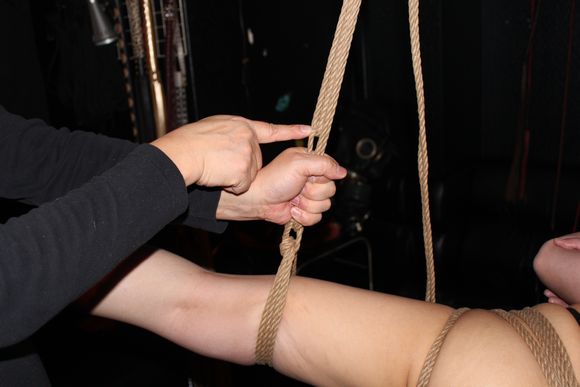

On this site, I'm going to explain comparatively simple methods of suspension.
But no matter how simple the method, suspension always involves supporting the weight of a human body with ropes, and is a very serious type of bondage, so you need to be careful of the following.
1. Make sure the suspended one is in good health.
2. Make sure the rope and harness used for suspension are capable of supporting the weight.
3. Always keep a close eye on the suspended one's condition so that you can notice any problems immediately.
Regarding (1.), if your partner is in bad health, it may become hard for them to withstand the suspension, so you shouldn't suspend them until they get better.
Also, you shouldn't suspend people when they are drunk, or immediately after they've eaten.
Of course, the same goes for you. If you are also in bad health, you shouldn't attend to suspend anyone. No one has the right to bind anyone else unless they're aware of this.
Regarding (2.), you won't be able to tell what condition the rope is in unless you regularly take care of it, so please make sure you're doing regular maintenance.
If a rope snaps during a suspension, the bound one will fall to the ground without being able to use their arms or legs, which could result in serious trauma to the face or head, so please be very careful.
まThe harness also needs to be strong enough to hold up a human body. Even with a person who weighs only 50kg, when you raise and drop their body, pressure equal to hundreds of kilograms will be exerted for an instant.
Sometimes, suspension can result in force being exerted in unexpected directions. The equipment needs to be capable of supporting not just vertical suspension, but horizontal and twisted pressure as well.
Using simple harnesses can result in accidents, so please make sure not to use that kind of equipment. (Sometimes they're so weak they can't even be called harnesses.)
Regarding (3.), this is basically a definition of the right to bind. Suspension exerts an intense amount of stress on the suspended one. Tying rope too tightly can cause numbness, so please play close attention to your partner.
Horizontal suspension is when you suspend someone who is lying down, as if on a bed.
In suspension, you don't pull the body up, but rather, let the rope carry the body (the weight). (Often, first-timers try to pull the body up.)
Here, we'll start from the point after completing chest and waist binding.
The suspension rope should be attached in this order: chest, leg, other leg, waist.
Slide the rope through these four ropes on the top and bottom of the chest.




You're just passing the rope through the rope head here, so there's no need to fasten it tightly.

When you do this, do not pull up the body with the suspension rope, as if you're hanging them.
All you should do is go back and forth between the chest rope and the carabiner. The suspension rope shouldn't feel tense.

(The above picture is a bad example of rope being applied on the kneecap)

(The above picture is a bad example of rope that's too far up)

Please don't apply rope below the knee. It'll just end up slipping off anyway once the knees bend.

Once one leg goes up, the body will lose its posture, so before raising the knee, make sure you let the bound one know and explain what kind of position will come next.
Don't pull up the body. Just let the rope carry it.
Height-wise, the knee should be at the same height as the chest.

Please make sure to support the bound one with your arms and body so that they don't start spinning.

Once both legs are raised, it's a battle of time.

This makes a huge difference, so please make sure to do it.

The waist should be at the same height as the chest and knees.
In the photo, I fastened the excess rope in a sail formation, but you don't need to do this if you don't have enough time.

It's easier to bend the legs instead of stretching them out, so please converse with your partner and decide.

This is how it looks when it's finished.
No matter what kind of suspension you're doing, the lowering process is the part you need to take the most care with.
Sometimes, I hear about accidents where people fall. Most of those accidents happen during this step.
When you unravel the suspension rope, do it with one hand, not both.
Use your other hand to grip the rope and keep it from falling.

(In the above image, I'm pointing to the rope head)

(The above image is a bad example of grabbing the rope in the wrong place.)
You should lower the body in the opposite order of how you raised it: waist, leg, other leg, chest.
Some women who especially enjoy this will keep their weight concentrated on the chest rope even after their legs are lowered, so please take care up until the very last step.